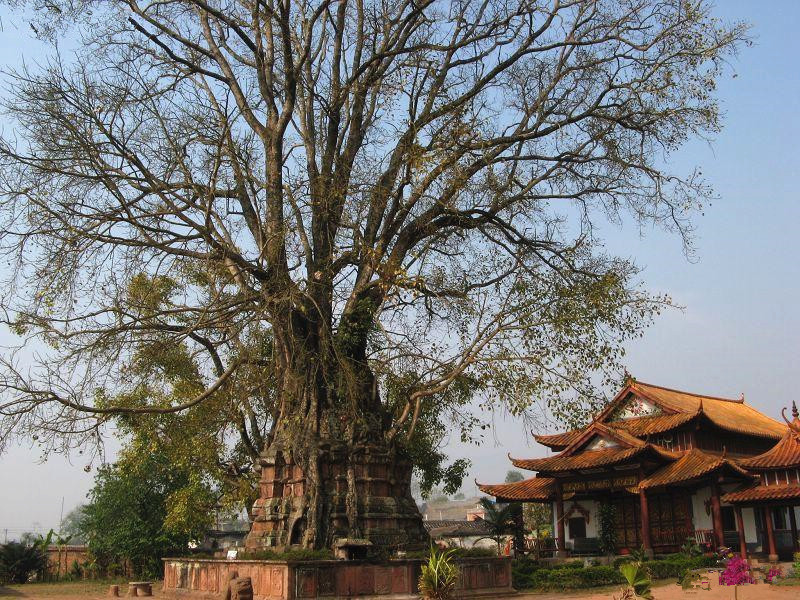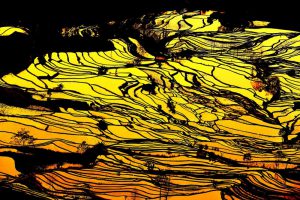
Tree-wrapped Pagoda and Tower-wraped Tree in Jinggu County, Puer
Chinese Name:景谷县树包塔塔包树
English Name: Tree-wrapped Pagoda and Tower-wraped Tree in Jinggu County, Puer
The Tree-wrapped Pagoda and Tower-wrapped Tree, located within the Dai Buddhist temple known as Guan Mian Temple in Jinggu County, Puer City, Yunnan, are two extraordinary and unique cultural landmarks. This iconic site, featuring two pagodas each intertwined with banyan trees, is renowned for its fusion of natural and architectural beauty. Below is a detailed guide about this attraction.
Location and Features
- Tree-wrapped Pagoda (树包塔): Located on the east side of the temple, this pagoda features a gourd-shaped structure with a square base of over 4 meters. It stands about 10 meters tall. A massive banyan tree, over two girths wide, grows from the center of the pagoda’s top, with its canopy spreading wide like an umbrella. The tree’s roots tightly embrace the stone structure, creating a beautiful and harmonious blend of nature and architecture.
- Tower-wrapped Tree (塔包树): Positioned on the west side of the temple, this structure also resembles a gourd-shaped pagoda. Here, a smaller banyan tree, about one girth thick, grows from the tower’s center. The white pagoda firmly wraps around the tree, creating a fascinating contrast of the ancient stone tower encasing the living tree within its structure.
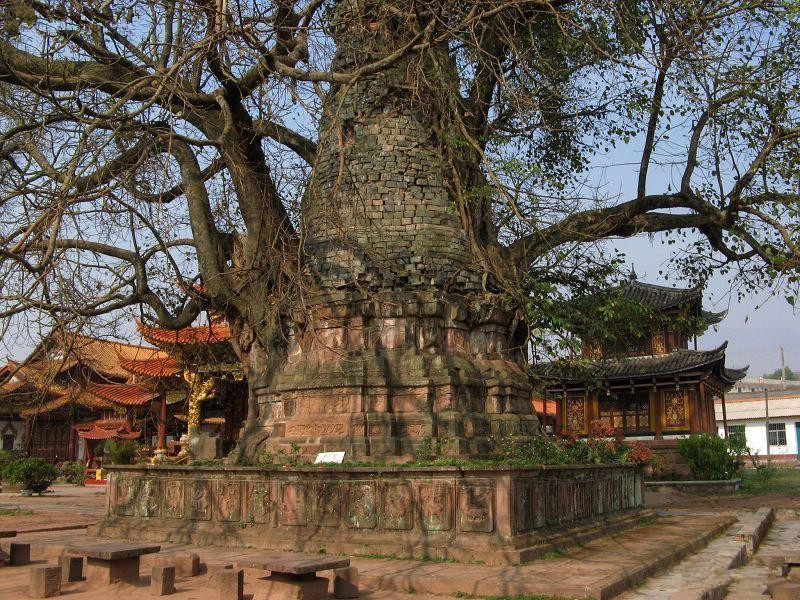
Historical Background and Significance
- Both pagodas were constructed in 1644. Due to the humid climate of Jinggu, birds deposited banyan seeds into the crevices of the pagoda bricks. Over centuries, these seeds germinated, with roots intertwining and wrapping around the pagodas, leading to the current breathtaking sight. This unique combination of natural growth and human-made structure has made the site a cultural and spiritual symbol in the region.
- The site is part of the Mengwo Zong Temple (勐卧总佛寺), the largest temple complex in Jinggu, historically serving as a central place of worship for the local Dai community. The name “Mengwo” refers to Jinggu’s ancient name, meaning “a place with salt wells.”
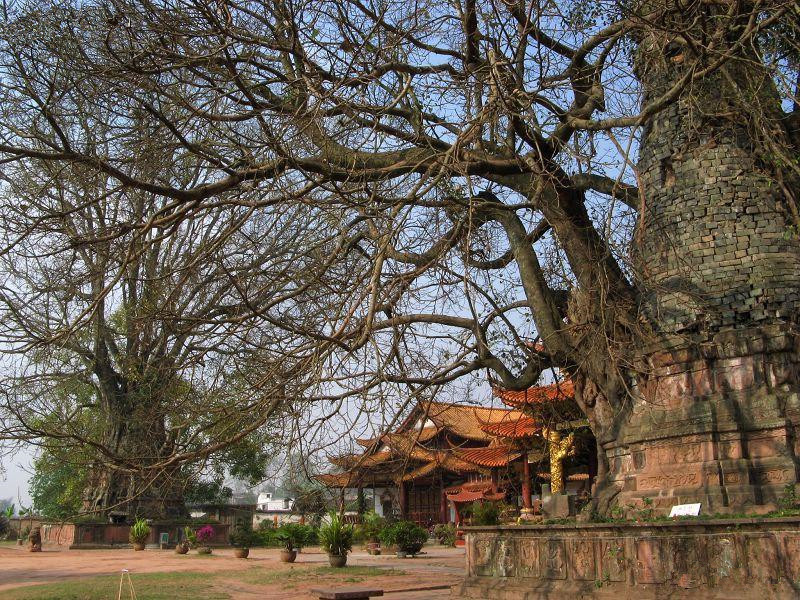
Best Time to Visit
- The ideal time to visit the Tree-wrapped Pagoda and Tower-wrapped Tree is during the dry season, between November and April. The weather is generally pleasant, making it easier to explore the temple grounds. During this time, the banyan trees are in full foliage, providing a vibrant green contrast against the stone pagodas.
How to Get There
- From Jinggu County Center: The temple is located within the town, so visitors can easily reach it on foot, by bicycle, or by local transport. The route is well-signposted with red-brown tourist signs.
- From Puer City: Puer is about 170 km from Jinggu County. Travelers can take a long-distance bus from Puer to Jinggu, which typically takes about 3-4 hours. Upon arrival in Jinggu, visitors can hire a taxi or take a local bus to reach the temple.
- By Private Vehicle: Renting a car is a convenient option for those traveling from Puer or other nearby cities. The roads are well-maintained, and signage to the temple is clear.

Useful Travel Tips
- Admission: The temple and pagoda complex are open to the public free of charge. Donations are often welcomed for temple maintenance.
- Dress Code: As a religious site, visitors should dress modestly. Wearing long pants or skirts and avoiding sleeveless tops is advisable.
- Photography: While photography is generally allowed, be respectful of the local culture and any worshippers present. Some inner temple areas might restrict photography.
- Local Culture: Jinggu County is predominantly inhabited by the Dai ethnic group, who practice Theravada Buddhism. Understanding and respecting local customs and practices will enhance your visit.
- Amenities: There are basic amenities near the temple, including small shops and stalls selling snacks, beverages, and local handicrafts. However, it’s a good idea to bring water and some snacks, especially if planning to spend a significant amount of time exploring.
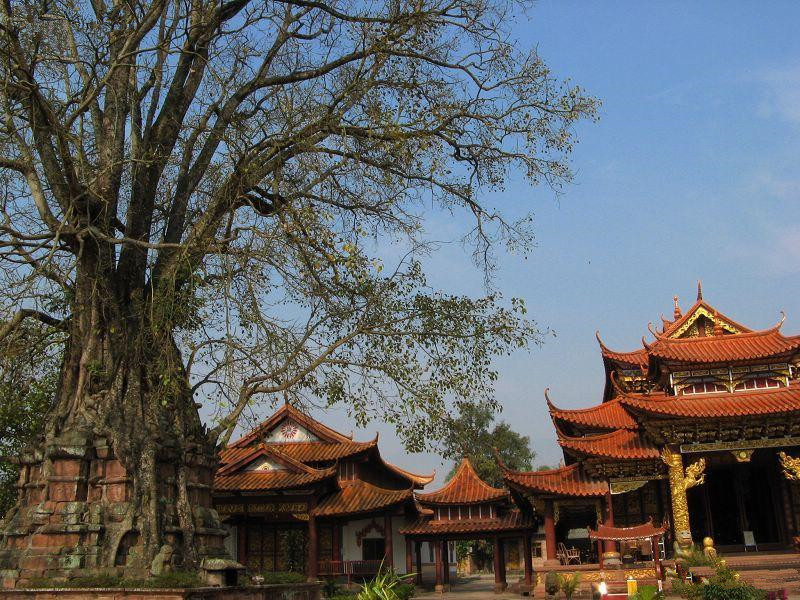
Conclusion
The Tree-wrapped Pagoda and Tower-wrapped Tree are must-see attractions for anyone visiting Jinggu County or Puer City. These sites offer a unique glimpse into the region’s cultural heritage, showcasing the harmonious coexistence of nature and architecture over centuries.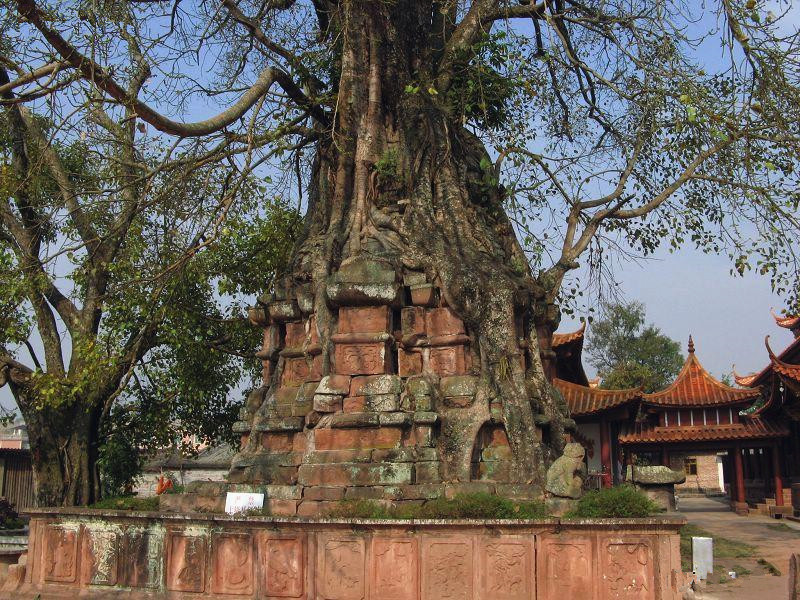

 7 Days GolfingTour
7 Days GolfingTour
 8 Days Group Tour
8 Days Group Tour
 8 Days Yunnan Tour
8 Days Yunnan Tour
 7 Days Shangri La Hiking
7 Days Shangri La Hiking
 11 Days Yunnan Tour
11 Days Yunnan Tour
 6 Days Yuanyang Terraces
6 Days Yuanyang Terraces
 11 Days Yunnan Tour
11 Days Yunnan Tour
 8 Days South Yunnan
8 Days South Yunnan
 7 Days Tea Tour
7 Days Tea Tour
 8 Days Muslim Tour
8 Days Muslim Tour
 12 Days Self-Driving
12 Days Self-Driving
 4 Days Haba Climbing
4 Days Haba Climbing
 Tiger Leaping Gorge
Tiger Leaping Gorge
 Stone Forest
Stone Forest
 Yunnan-Tibet
Yunnan-Tibet
 Hani Rice Terraces
Hani Rice Terraces
 Kunming
Kunming
 Lijiang
Lijiang
 Shangri-la
Shangri-la
 Dali
Dali
 XishuangBanna
XishuangBanna
 Honghe
Honghe
 Kunming
Kunming
 Lijiang
Lijiang
 Shangri-la
Shangri-la
 Yuanyang Rice Terraces
Yuanyang Rice Terraces
 Nujiang
Nujiang
 XishuangBanna
XishuangBanna
 Spring City Golf
Spring City Golf
 Snow Mountain Golf
Snow Mountain Golf
 Stone Mountain Golf
Stone Mountain Golf

